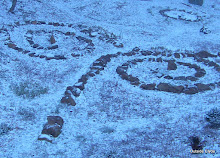Massive Live Oaks line the perimeter of a wet prairie in the heart of Florida. Paynes Prairie was once a large lake. A sinkhole opened in the north east corner and drained the waters away leaving the lake bed low and wet or often dry.

Old cave paintings line a tunnel beneath railroad tracks for trains that used to pass overhead.

Is it a donkey or a deer?

The wildlife was abundant on an overcast, breezy and cool winter day. A Heron close by patiently posed for pictures.

Most of the rest of the inhabitants kept their distance from the trail. It required the zoom lens. Without a tripod, I should be happy with the results even if they aren't exactly National Geographic quality.

This is what we came for, the Sandhill Cranes. Perfect water conditions have increased the usual 2 to 3 thousand winter population to 5 thousands cranes. A special bonus was seeing two of the five endangered Whooping Cranes, the white crane, that winter on Paynes Prairie.

There are 380 Whooping Cranes left at this point. A young female approaching breeding age returned to the prairie this winter with a mate. They didn't cooperate close enough to me for a wedding photo.

Sandhill Cranes off in the distance.


Sandhill Cranes fly by.

A prairie resident very close by with a lineage far older than this dry lake bed watches dozens of small hominids watching thousands of cranes. Will one of them get close enough?

For an afternoon snack?

They wait patiently.

Having survived the turning tides for thousands of millennia.






12 comments:
What an exciting stroll through the Prairie Christopher. I am facinated by the Live Oaks, especially when they are so big. I like to see the moss hanging from them. I think it a charming scene. Those gators are certainly interesting creatures. I hope they don't eat the Whoopers.
Wow. I'm glad you were using a zoom.
This state is full of ancient things. You never know when a gator might run across the road in front of you. People from out of state don't really realize how dangerous it could be if they don't watch or know where they are sitting. A log could be a gator. One crawled through our veggie garden one time. Left it's tail mark.
Christopher, that Live Oak is so beautiful! Living in MD, I miss them . . . . There is nothing like a Live Oak tree. I enjoyed your other photos, too - how wonderful to see the cranes.
Great pictures. The swamp is wonderful on a warm winter day.
Is there a boardwalk, or do you just muck through the mush?
The large Live Oaks are a pretty awesome tree. There are almost as many of them as there are gators. The oaks are just easier to see.
Chuck I sure wished the cranes had been closer. The gator was very close to an observation deck for an elevated view.
Cheryl the trail was on top of a dike next to a drainage canal that led to Alachua Sink where the water goes underground. You wouldn't want to muck around out there on foot with the gators, snakes and free range bison. Maybe on horse back.
Hi Christopher, I thought the heron photo quite worthy of any publication. Those live oaks are so regal. We once paid money to see the Angel Oak, outside of Charleston, SC. It was held together with massive chains and steel cables. It was worth the money just to see it. It seems you are having fun traipsing around FL. There may be snow on the mountain just now, a light covering. Enjoy the warmth of your family and the surroundings!
Frances
It looks pretty National Geographic-worthy to me, Christopher - loved seeing the alligator and the cranes. Who made the cave paintings and when were they made?
It's funny - we have zillions of liveoaks here in Austin but there are probably as many that are newly planted trees in subdivisions as there are old specimens, and they don't look romantic.
Some of the older ones have amazingly twisted trunks that add character to the landscape, but our drier climate means ball moss not Spanish moss. Instead of trees draped in grey strands looking all Southern Gothic, the ball moss looks messy and/or comical, like tribbles stuck all over the trees.
Annie at the Transplantable Rose
I really enjoyed these pictures, Christopher! Man, those gators are sooo cool. I thought that was the best part about Florida when I went as a kid (tomboy)...we saw them in the ditches along the road by Cape Canaveral. I'm glad to see some whooping cranes with the sandhills, the International Crane Foundation is right here in Wisconsin (Baraboo). It was a treat to see where "my" sandhills go for the winter! :)
Lisa now I know where Florida's sandhill cranes go in the summer. I saw them, more heard really, at the lake at the botanical garden, in pastures at the university vet school and thousands of them on the prairie.
It's a donkey, i know it!
Ok. It's a donkey. It is to late for a poll in the fast paced world of gardening blogging.
Post a Comment